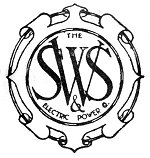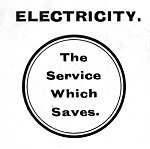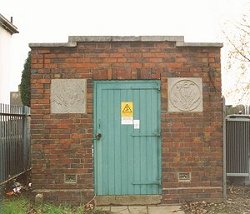 |
MEB at Major Street |
 |
I Early days
Electricity is used as a source of power, heat and light both in industry and the home. To-day we cannot imagine how we would get on without it. But it has an odd history. It may have been known about in the ancient world, but only as a curiosity. Unlike many industries its extensive use came not from the work of practical men but from the work of theoretical scientists, whose findings only slowly became applied. The reason for this slow growth may be not so much any problems inherent in electricity but the fact that it was mainly seen as a potential source of power and the steam engine was doing that job very well.
But some people did see its potential. And one of these people was a Bilston man,
John Corfield, who was born at Hurst Hill, near Bilston, in 1830. These lines come from his poem "Allan Chase", which mainly expressed his views on social reform and was published in 1877.
This is an age of knowledge, for we find
Our learned men resolved that she must reign
Till everyone on earth of human kind
Is subject to her rule: and to obtain
So great a victory, they are not content
That steam the mighty purpose should display;
They've snatched the lightning from its element
And made it serve to speed her on her way.
A rather better known poet, Alfred, Lord Tennyson, wrote: "Let the great world spin forever down the ringing grooves of change". The "ringing grooves" were railway lines. Tennyson had not only misunderstood how railway lines worked but seemed to think that railways were where the future lay. Corfield did much better. Even in 1877 he recognised that not only was electricity more important than railways but that the information age was upon us. Tennyson would never have understood a computer and the Internet; Corfield might well have done - and have understood why they were important.
Up until the 1860s the only way to get a supply of electricity was from a battery, with all the shortcomings that implied. Generators and dynamos were hesitantly developed in the 1860s but the first reliable device which could produce electricity consistently over long periods of time was the Gramme dynamo, introduced in 1870. At about the same time Thomas Parker, who was later involved in the Electric Construction Company of Wolverhampton, was experimenting with dynamos at Coalbrookdale. After building several models he built a large dynamo for the Coalbrookdale Iron Works. This was one of the first dynamos to be put to practical use. He was also designed a lead-acid accumulator and jointly held the original patent with French scientist Garon Plante.
During the rest of the century the issue was clouded by the dispute between the relative usefulness of alternating and direct current - a dispute never fully resolved and which lead to there being a mixture of AC and DC pubic supplies right up until the middle of the 20th century.
At the end of the 19th century it was quite common for individual companies or people to install their own generators to provide their own supply, to their factory or to their stately home. For example, Sir Gerald Mander installed a generating plant at Wightwick Manor in 1895 on the recommendation of the famous Wolverhampton electrical engineer, Thomas Parker. The equipment was supplied by the Wolverhampton firm, E.C.C.. It consisted of a steam-driven generator which supplied 100 volts D.C. for electric lighting.. A set of back up batteries were added at a later date. You can still find such private supplies and there are still many back up generators in hospitals, hotels and other public buildings to provide power when the public supply fails.
But the original demand for more electricity was mainly for street lighting and for that a central, distributed supply made obvious economic sense. The first such plant, the Holborn Viaduct plant, opened in England in 1882. These forms of public supply were provided either by private companies set up for the purpose or by local authorities. Both, of course, needed statutory authority to put cables and pylons over other people's land and to lay cables in streets; and both were regulated under Acts of Parliament.
By the end of the century most of the technical problems had been cracked and systems of distributing electricity both overground in pylons and underground through insulated cables had been proven. By 1900 it was clear that electric lighting was at least as good as gas lighting and likely to overtake it in popularity. The problem that remained with electricity was the one of distributing a supply, particularly to rural areas. Industry had taken up electric power very widely, if not quite universally. But even so since the major demand was for lighting, power suppliers found that if they were to meet that peak they had to have equipment which would over-produce during daylight hours. For this reason they were happy to see electric traction, in the form of trams, come on the scene.
Somewhere there must be a book which records the history of electricity supply in England but I have not yet come across it. When I do I might be able to say more about the supply to other areas of the Black Country and I may have to revise what I have here about the Wolverhampton supply.
II Supply to the Black Country Area
(The information for this section was supplied by John Hughes. Duncan Nimmo identified the sub-stations).
When the MEB was formed it took over from the various bodies who were at that time supplying electricity to the area. There were more than 26 such bodies, which were either local authorities, such as Wolverhampton Borough Council or private companies such as the Midland Electricity Corporation which supplied Bilston, amongst many other places. One of the main functions of the MEB at its inception was to bring these diverse bodies and their differing standards together, including such basic matters as whether the domestic supply as AC or DC. One example of these predecessors, and a very big one, was the Shropshire, Worcestershire and Staffordshire Power Company. The company supplied all or part of the three counties in their title and this inlcuded many Black Country areas. Two of their power stations locally were at Smethwick and Stourport. Their head office was at Mucklow's Hill, Halesowen.
 |
 |
 |
Bilston was supplied by the Midland Electricity Corporation Ltd.. Their rather odd motto was "For Power and Distribution". Their offices were in Temple Street, Birmingham, but they did not supply Birmingham. Their area ran from Bilston down to Stourbridge and included local areas such as Wednesfield and Willenhall. And the Ocker Hill Power Station was one of theirs. Some of their sub-stations can still be seen in the area.

An MEC sub-station, probably dating back to the 1930s. This one is on Amos Road, near the park. |
This close up of the logo comes from the corner of Amos Road and Prestwood Lane. They were cast in concrete. |
Wolverhampton Borough Council had its own supply and they also supplied a wide area in south Staffordshire